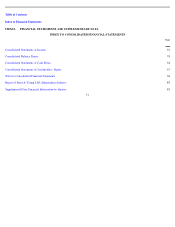Intel 2003 Annual Report Download - page 64
Download and view the complete annual report
Please find page 64 of the 2003 Intel annual report below. You can navigate through the pages in the report by either clicking on the pages listed below, or by using the keyword search tool below to find specific information within the annual report.
Table of Contents
Index to Financial Statements
INTEL CORPORATION
NOTES TO CONSOLIDATED FINANCIAL STATEMENTS (Continued)
cash flow hedge were to be discontinued because it is probable that the original hedged transaction will not occur as anticipated, the unrealized
gains or losses on the related derivative would be reclassified into earnings. Subsequent gains or losses on the related derivative instrument
would be recognized in income in each period until the instrument matures, is terminated or is sold.
For all periods presented, the portion of hedging instruments’ gains or losses excluded from the assessment of effectiveness and the
ineffective portions of hedges had an insignificant impact on earnings for both cash flow and fair value hedges. There was no significant impact
to results of operations from discontinued cash flow hedges as a result of forecasted transactions that did not occur. For all periods presented,
insignificant amounts of deferred gains or losses were reclassified from accumulated other comprehensive income to depreciation expense
related to the company’s foreign currency capital purchase hedging program. The company estimates that less than $10 million of net
derivative gains included in other comprehensive income will be reclassified into earnings within the next 12 months.
Inventories
Inventory cost is computed on a currently adjusted standard basis (which approximates actual cost on an average or first-in, first-out
basis). Work in process and finished goods inventory are determined to be saleable based on a demand forecast within a specific time horizon,
generally six months or less. Inventory in excess of saleable amounts is not valued, and the remaining inventory is valued at the lower of cost
or market. Inventories at fiscal year-ends were as follows:
Property, Plant and Equipment
Property, plant and equipment, net at fiscal year-ends was as follows:
Property, plant and equipment is stated at cost. Depreciation is computed for financial reporting purposes principally using the straight-
line method over the following estimated useful lives: machinery and equipment, 2–4 years; buildings, 4–40 years. Reviews are regularly
performed to determine whether facts and circumstances exist which indicate that the carrying amount of assets may not be recoverable or that
the useful life is shorter than originally estimated. The company assesses the recoverability of its assets by comparing the projected
undiscounted net cash flows associated with the related asset or group of assets over their remaining lives against their respective carrying
amounts. Impairment, if any, is based on the excess of the carrying amount over the fair value of those assets (see “Note 19: Impairment of
Long-Lived Assets”). If assets are determined to be recoverable, but the useful lives are shorter than originally estimated, the net book value of
the assets is depreciated over the newly determined remaining useful lives.
Goodwill
Effective the beginning of 2002, the company discontinued amortizing the remaining goodwill balances under the provisions of
Statement of Financial Accounting Standards (SFAS) No. 142, “Goodwill and Other Intangible Assets.” All remaining and future acquired
goodwill is subject to an impairment test in the fourth quarter of each year, or earlier if indicators of potential impairment exist, using a fair-
value-based approach. See “Note 16: Goodwill” for a discussion of goodwill impairments.
59
(In Millions)
2003
2002
Raw materials
$
333
$
223
Work in process
1,490
1,365
Finished goods
696
688
Total inventories
$
2,519
$
2,276
(In Millions)
2003
2002
Land and buildings
$
12,651
$
11,374
Machinery and equipment
24,233
22,800
Construction in progress
1,808
2,738
38,692
36,912
Less accumulated depreciation
(22,031
)
(19,065
)
Total property, plant and equipment, net
$
16,661
$
17,847
























